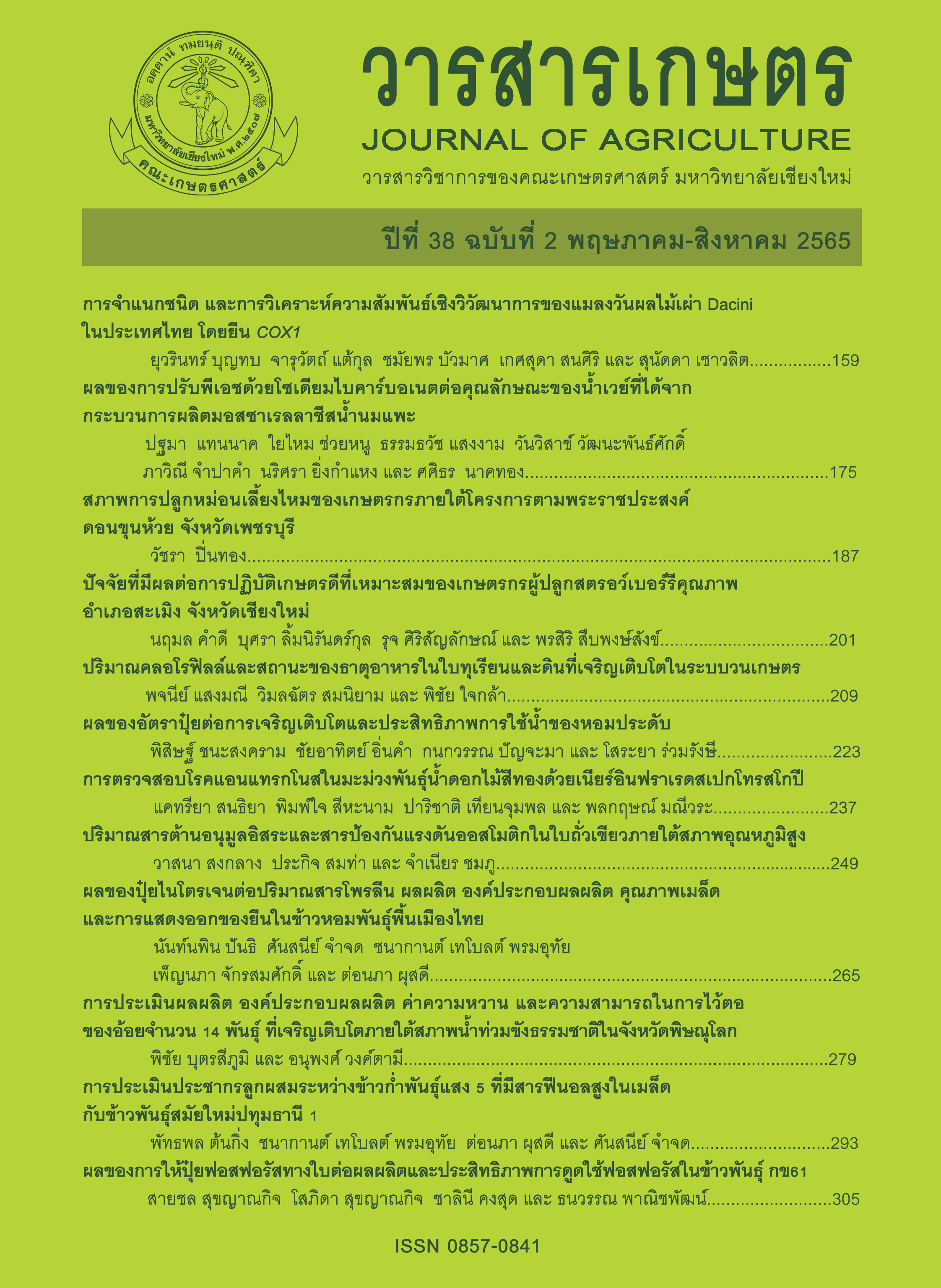ผลของการให้ปุ๋ยฟอสฟอรัสทางใบต่อผลผลิตและประสิทธิภาพการดูดใช้ฟอสฟอรัสในข้าวพันธุ์ กข61
Main Article Content
บทคัดย่อ
การให้ปุ๋ยทางใบเป็นวิธีการหนึ่งในการเพิ่มประสิทธิภาพการใช้ปุ๋ยของพืช โดยงานวิจัยนี้มีวัตถุประสงค์เพื่อประเมินการให้ปุ๋ยฟอสฟอรัสทางดินร่วมกับการพ่นปุ๋ยฟอสฟอรัสทางใบที่สามารถส่งเสริมการสร้างผลผลิต และประสิทธิภาพการดูดใช้ฟอสฟอรัสในข้าวพันธุ์ กข61 ที่ปลูกในชุดดินอยุธยา จังหวัดพระนครศรีอยุธยา วางแผนการทดลองแบบสุ่มสมบูรณ์ภายในบล็อก (RCBD) จำนวน 3 ซ้ำ 11 ตำรับทดลอง ผลการทดลองพบว่า การให้ปุ๋ยฟอสฟอรัสอัตรา 0.5 เท่าของค่าวิเคราะห์ดินร่วมกับการพ่นปุ๋ยฟอสฟอรัสทางใบอัตรา 1.28 กิโลกรัม P2O5/ไร่ ให้ผลผลิตเมล็ดสูงสุด (1,185 กิโลกรัมต่อไร่) ซึ่งไม่แตกต่างทางสถิติกับการให้ปุ๋ยฟอสฟอรัสตามวิธีการของเกษตรกร (10 กิโลกรัม P2O5/ไร่) และกรรมวิธีดังกล่าวยังให้ค่าการดูดใช้ฟอสฟอรัสรวมในข้าวสูงที่สุดด้วย (10.17 กิโลกรัม P/ไร่) การให้ปุ๋ยฟอสฟอรัสทางดินอัตรา 0.5 เท่าของค่าวิเคราะห์ดินให้ค่าสหสัมพันธ์เชิงเส้นระหว่างผลผลิตเมล็ด (R2= 0.89*) และปริมาณการดูดใช้ฟอสฟอรัสในเมล็ด (R2= 0.95**) กับอัตราการพ่นปุ๋ยฟอสฟอรัสทางใบสูงกว่าการให้ปุ๋ยฟอสฟอรัสทางดินอัตรา 0.25 เท่าของค่าวิเคราะห์ดิน ด้านประสิทธิภาพการดูดใช้ฟอสฟอรัสในข้าวนั้น การพ่นปุ๋ยฟอสฟอรัสทางใบในอัตราต่าง ๆ ส่งผลให้ข้าวพันธุ์ กข61 มีประสิทธิภาพการดูดใช้ฟอสฟอรัสสูงกว่าการให้ปุ๋ยฟอสฟอรัสทางดิน ดังนั้นการให้ปุ๋ยฟอสฟอรัสอัตรา 0.5 เท่าของค่าวิเคราะห์ดินร่วมกับการพ่นปุ๋ยฟอสฟอรัสทางใบอัตรา 1.28 กิโลกรัม P2O5/ไร่ เป็นวิธีการที่เหมาะสมในการเพิ่มผลผลิตและช่วยปรับปรุงประสิทธิภาพการใช้ปุ๋ยฟอสฟอรัสในข้าวพันธุ์ กข61 ที่ปลูกในพื้นที่จังหวัดพระนครศรีอยุธยา
Article Details

อนุญาตภายใต้เงื่อนไข Creative Commons Attribution-NonCommercial-NoDerivatives 4.0 International License.
เอกสารอ้างอิง
Akinrinde, E.A. and T. Gaizer. 2006. Differences in the performance and phosphorus-use efficiency of some tropical rice (Oryza sativa L.) varieties. Pakistan Journal of Nutrition 5(3): 206-211.
Attanandana, T. 2007. Paddy Soil Science. Department of Soil Science, Faculty of Agriculture, Kasetsart University, Bangkok. 359 p. (in Thai)
Attanandana, T. and J. Chanchareonsook. 1999. Manual of Soil and Plant Analysis. Department of Soil Science, Faculty of Agriculture, Kasetsart University, Bangkok. 108 p. (in Thai)
Bationo, A. and K.A. Kumar. 2002. Phosphorus use efficiency as related to sources of P fertilizers, rainfall, soil, crop management, and genotypes in the West African semi-arid tropics. pp. 145-154. In: J.J. Adu-Gyamfi (ed.). Food Security in Nutrient-Stressed Environments: Exploiting Plants’ Genetic Capabilities. Springer, Dordrecht.
Bray, R.H. and L.T. Kurtz. 1945. Determination of total, organic, and available forms of phosphorus in soils. Soil Science 59(1): 39-46.
Bumphenyoo, W. and S. Ruamrungsri. 2003. Deficiency of mineral nutrients in Globba ssp. Journal of Agriculture 19(2): 116-124. (in Thai)
Division of Rice Research and Development. 2021. Rice RD61 variety. (Online). Available: http://library.ricethai-land.go.thimages/stories/brochure/september2017/rd61.pdf (January 3, 2021). (in Thai)
Division of Soil Survey and Soil Resource Research. 2019. Soil map of Phranakhon Si Ayutthaya province. (Online). Available: http://oss101.ldd.go.th/web_thaisoilinf/central/Ayutthaya/ay_map/ay_series/ay_series58.html (July 7, 2019). (in Thai)
Dobermann, A. and T. Fairhurst. 2000. Rice: Nutrient Disorders and Nutrient Management. Oxford Graphic Printers, Singapore. 191 p.
Fageria, N.K., O.P. de Morais, A.B. dos Santos and M.J. Vasconcelos. 2014. Phosphorus use efficiency in upland rice genotypes under field conditions. Journal of Plant Nutrition 37(5): 633-642.
Fageria, N.K., O.P. Morais, V.C. Baligar and R.J. Wright. 1988. Response of rice cultivars to phosphorus supply on an oxisol. Fertilizer Research 16: 195-206.
FAO Project Staff and Land Classification Division. 1973. Soil Interpretation Handbook for Thailand. Land Classification Division, Department of Land Development, Bangkok. 169 p.
Gee, G.W. and J.W. Bauder. 1986. Particle-size analysis. pp. 383-411. In: A. Klute (ed.). Methods of Soil Analysis Part 1: Physical and Mineralogical Methods. Soil Science Society of America, Inc., Madison, Wisconsin.
Girma, K., K.L. Martin, K.W. Freeman, J. Mosali, R.K. Teal, W.R. Raun, S.M. Moges and D.B. Arnall. 2007. Determination of optimum rate and growth stage for foliar applied phosphorus in corn. Communications in Soil Science and Plant Analysis 38(9-10): 1137-1154.
Jiang, B.S., J.L. Shen, M.H. Sun, Y.J. Hu, W.Q. Jiang, J. Wang, Y. Li and J.S. Wu. 2021. Soil phosphorus availability and rice phosphorus uptake in paddy fields under various agronomic practices. Pedosphere 31(1): 103-115.
Mosali, J., K. Desta, R.K. Teal, K.W. Freeman, K.L. Martin, J.W. Lawles and W.R. Raun. 2006. Effect of foliar application of phosphorus on winter wheat grain yield, phosphorus uptake, and use efficiency. Journal of Plant Nutrition 29(2): 2147-2163.
Murphy, J. and J.P. Riley. 1962. A modified single solution method for determination of phosphate in natural waters. Analytica Chimica Acta 27: 31-36.
Osotsapar, Y. 2015. Plant Nutrition. Kasetsart University Press, Bangkok. 548 p. (in Thai)
Osotsapar, Y., A. Wongmaneeroj and C. Hongprayoon. 2013. Fertilizer for Sustainable Agriculture. Kasetsart University Press, Bangkok. 519 p. (in Thai)
Penn, C.J. and J.J. Camberato. 2019. A critical review on soil chemical processes that control how soil pH affects phosphorus availability to plants. Agriculture 9(6): 120, doi: 10.3390/agriculture9060120.
Pequerul, A., C. Perez, P. Madero, J. Val and E. Monge. 1993. A rapid wet digestion method for plant analysis. pp. 3-6. In: M.A.C. Fragoso and M.L. van Beusichem (eds.). Optimization of Plant Nutrition. Springer Science+Business Media, Dordrecht.
Pierzynski, G.M., R.W. McDowell, and J.T. Sims. 2005. Chemistry, cycling and potential movement of inorganic phosphorus in soil. pp. 53-86. In: J.T. Sims and A.N. Sharpley (eds.). Phosphorus: Agriculture and the Environment. American Society of Agronomy, Crop Science Society of America, Soil Science Society of America. Inc. Madison, Wisconsin.
Rhoades, J.D. 1996. Salinity: Electrical conductivity and total dissolved solids. pp. 417-435. In: D.L. Sparks, A.L. Page, P.A. Helmke, R.H. Loeppert, P.N. Soltanpour, M.A. Tabatabai, C.T. Johnston and M.E. Sumner (eds.). Methods of Soil Analysis Part 3: Chemical Methods. Soil Science Society of America, Inc., Madison, Wisconsin.
Roberts, T.L. and A.E. Johnston. 2015. Phosphorus use efficiency and management in agriculture. Resources, Conservation and Recycling 105: 275-281.
Thomas, G.W. 1982. Exchangeable cations. pp. 159-165. In: A.L. Page, R.H. Miller and D.R. Keeney (eds.). Methods of Soil Analysis Part 2: Chemical and Microbiological Properties. Soil Science Society of America, Inc. Madison, Wisconsin.
Thomas, G.W. 1996. Soil pH and soil acidity. pp. 475-490. In: D.L. Sparks, A.L. Page, P.A. Helmke, R.H. Loeppert, P.N. Soltanpour, M.A. Tabatabai, C.T. Johnston and M.E. Sumner (eds.). Methods of Soil Analysis Part 3: Chemical Methods. Soil Science Society of America, Inc., Madison, Wisconsin.
Sherchand, K. and G.M. Paulsen. 1985. Response of wheat to foliar phosphorus treatments under field and high temperature regimes. Journal of Plant Nutrition 8(12): 1171-1181.
Sukyankij, S., S. Sawatdikarn, S. Samithiarporn and T. Panich-pat. 2021. Effects of lime material and waterlogging period on availability of phosphorus and yield of Hom Pathum rice in soils of Phranakhon Si Ayutthaya province. Khon Kaen Agriculture Journal 49(4): 842-855. (in Thai)
Walkley, A. and I.A. Black. 1934. An examination of degtjareff methods for determining soil organic matter, and a proposed for modification of the chromic acid titration method. Soil Science 37(1): 29-38.
Zambrosi, F.C.B. 2019. Foliar phosphorus applications in the forms of phosphate and phosphite have contrasting effects on wheat performance under field conditions. Journal of Crop Science and Biotechnology 22(5): 395-401.


